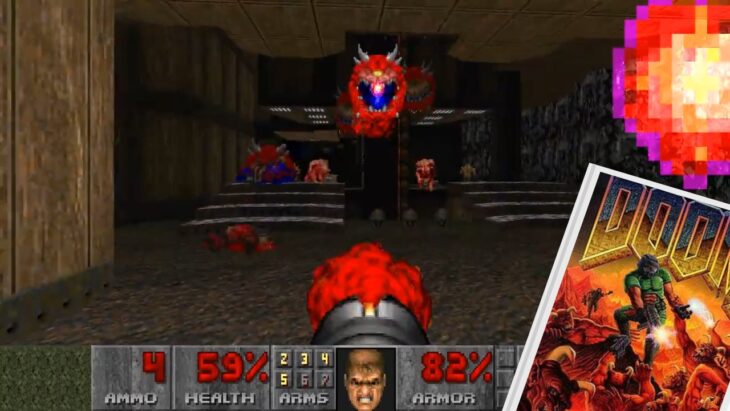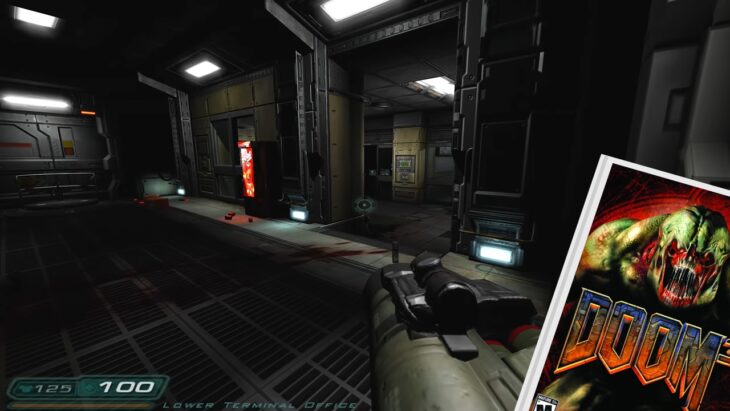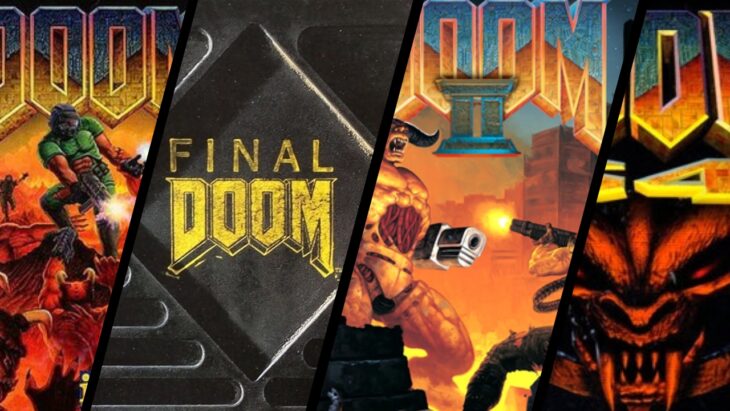The “Doom” series, developed by id Software, is one of the most iconic in the history of video games. Its influence on the first-person shooter genre is undeniable, and its legacy continues to grow with each new installment.
For both newcomers and die-hard fans, here’s a comprehensive look at all the Doom games, in order of their release.
Table of Contents
ToggleThe Birth of a Legend: 1990s

The 1990s witnessed the inception of the series, setting the stage for a revolution in the gaming industry.
Doom (1993)
The game that started it all. Released in 1993, the original “Doom” introduced gamers to the fast-paced, demon-slaying action that would define the series.
- Gameplay: Players assume the role of the Slayer, battling through hordes of demons from Hell. The game was notable for its 3D graphics, multiplayer mode, and modding capabilities.
- Legacy: It has set the standard for first-person shooters and is often credited with popularizing the genre. Its success led to several expansions and sequels.
Doom II: Hell on Earth (1994)
Building on the success of the original, “Doom II” was released just a year later, offering more levels, enemies, and weapons.
- Storyline: The game continues the story of the first installment, with Hell’s demons invading Earth. The Slayer must once again rise to the challenge and save humanity.
- Enhancements: While the core gameplay remained largely unchanged, the new installment introduced new levels and enemies, as well as the iconic Super Shotgun.
Final Doom (1996)
“Final Doom” isn’t a direct sequel but rather a compilation of two new 32-level episodes: “TNT: Evilution” and “The Plutonia Experiment.”
- Community Collaboration: Interestingly, both episodes were created by the fan community and not by id Software directly. They were, however, officially sanctioned and released as a commercial product.
- Gameplay: While offering new levels, it didn’t introduce new weapons or enemies. It was, however, praised for its challenging level design and engaging gameplay.
Doom 64 (1997)
Released exclusively for the Nintendo 64, “Doom 64” is more than just a port of the original games. It offers an entirely new experience with redesigned graphics and new levels.
- Visual Overhaul: The game featured entirely new sprites and textures, giving it a distinct look compared to its predecessors.
- Story Continuation: “Doom 64” picks up where the previous entry has left off, with battling resurrected demons. It’s noteworthy for introducing lore elements that would be referenced in later games.
The Modern Reimagining: 2000s and 2010s

The new millennium saw id Software taking the series in a fresh direction, with a focus on narrative and updated gameplay mechanics.
Doom 3 (2004)
“Doom 3” marked a departure from the series’ run-and-gun roots, incorporating elements of survival horror and a more in-depth storyline.
- Atmosphere & Story: Set on Mars, players must navigate the dark and claustrophobic corridors of a research facility overrun by demons. The game delves deeper into the origins of the demonic invasion and the experiments that led to it.
- Reception: While some long-time fans missed the fast-paced action of the original games, this one was praised for its graphics, atmosphere, and storytelling.
Doom (2016)
After a long hiatus, the series returned to its roots with “Doom (2016),” a reboot that captures the essence of the original games while introducing modern gameplay mechanics.
- Back to Basics: The game emphasizes fast-paced action, with the Slayer tearing through demons using an arsenal of powerful weapons.
- Modern Touches: While the gameplay is reminiscent of the original title, the 2016 reboot incorporates modern features like weapon upgrades, challenges, and a detailed lore that expands the series’ universe.
Doom Eternal (2020)
“Doom Eternal” continues the story of the Slayer, a legendary warrior who battles the forces of Hell. In this installment, Earth has been overrun by demonic forces, and it’s up to him to stop them.
The game introduces new enemies, weapons, and gameplay mechanics, such as the “Destructible Demons” system where enemies’ bodies degrade in real-time as they take damage. The game was praised for its fast-paced action, intricate level design, and the addition of new gameplay mechanics that added depth to the combat.
The soundtrack, composed by Mick Gordon, was also widely acclaimed for its heavy metal tracks that perfectly complemented the game’s intense action.
In addition to the main campaign, “Doom Eternal” also introduced a new 2 vs. 1 multiplayer mode called “Battlemode,” where two players take on the roles of demons trying to defeat one player as the Slayer.
What about the Movie?
The “Doom” movie refers to a 2005 action-horror film directed by Andrzej Bartkowiak and based on the popular video game series of the same name by id Software. The film stars Karl Urban, Rosamund Pike, and Dwayne “The Rock” Johnson.
The Plot
The movie is set on a research facility on Mars, where a portal to an ancient city has been discovered. A group of Marines, led by Sarge (Dwayne Johnson) and including Reaper (Karl Urban), is sent in to investigate after receiving a distress call from the facility.
They discover that the researchers have been turned into zombies and monsters due to a genetic experiment gone wrong. The team must then battle these creatures to save what’s left of the facility and prevent the outbreak from reaching Earth.
Reception
The “Doom” movie was generally not well-received by critics, who criticized its plot, character development, and deviation from the source material. It did have some moments that fans of the game appreciated, such as the first-person shooter sequence that emulated the gameplay experience.
In the years since its release, the movie has gained a bit of a cult following among fans of the game and those who appreciate its blend of action and horror. It’s worth noting that many fans of the “Doom” video game series were disappointed with the film’s adaptation, feeling it didn’t capture the essence of the games.
There have been discussions and hopes among fans for a more faithful adaptation of the franchise in the future, especially given the success and popularity of the recent video game reboots (like the ones released back in 2016 and in 2020).
FAQs
Which Doom game introduced the BFG weapon?
The BFG, or “Big F***ing Gun”, was introduced in the original game.
Was there a significant gap in the release of any Doom games?
Yes, there was a decade-long gap between “Doom 3” (2004) and the reboot “Doom” (2016).
Which Doom game is considered a reboot of the series?
The one released in 2016 is considered a reboot of the series.
Are all Doom games first-person shooters?
Yes, all main titles in the series are first-person shooters. However, some spin-offs and adaptations may vary in gameplay style.
Summary
The “Doom” series has seen its ups and downs over the years, but its influence on the gaming industry is undeniable. From its humble beginnings in the 1990s to its modern reimagining in the 21st century, it still remains a testament to the enduring appeal of fast-paced, demon-slaying action.
Whether you’re a veteran fan or a newcomer to the series, there’s no better time to dive into the universe and experience the evolution of this iconic franchise.



